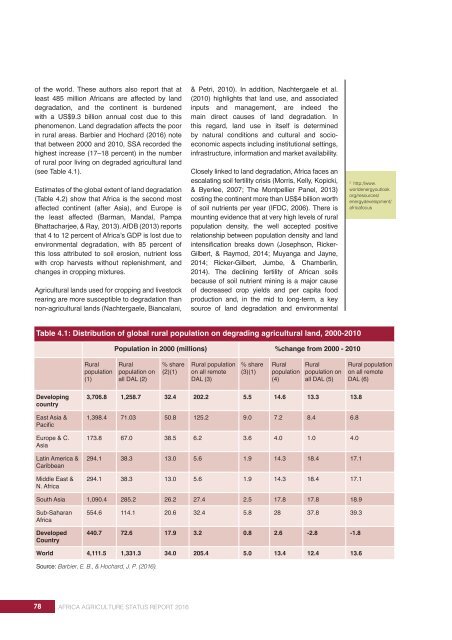AFRICA AGRICULTURE STATUS REPORT 2016
AASR-report_2016-1
AASR-report_2016-1
You also want an ePaper? Increase the reach of your titles
YUMPU automatically turns print PDFs into web optimized ePapers that Google loves.
of the world. These authors also report that at<br />
least 485 million Africans are affected by land<br />
degradation, and the continent is burdened<br />
with a US$9.3 billion annual cost due to this<br />
phenomenon. Land degradation affects the poor<br />
in rural areas. Barbier and Hochard (<strong>2016</strong>) note<br />
that between 2000 and 2010, SSA recorded the<br />
highest increase (17–18 percent) in the number<br />
of rural poor living on degraded agricultural land<br />
(see Table 4.1).<br />
Estimates of the global extent of land degradation<br />
(Table 4.2) show that Africa is the second most<br />
affected continent (after Asia), and Europe is<br />
the least affected (Barman, Mandal, Pampa<br />
Bhattacharjee, & Ray, 2013). AfDB (2013) reports<br />
that 4 to 12 percent of Africa’s GDP is lost due to<br />
environmental degradation, with 85 percent of<br />
this loss attributed to soil erosion, nutrient loss<br />
with crop harvests without replenishment, and<br />
changes in cropping mixtures.<br />
Agricultural lands used for cropping and livestock<br />
rearing are more susceptible to degradation than<br />
non-agricultural lands (Nachtergaele, Biancalani,<br />
& Petri, 2010). In addition, Nachtergaele et al.<br />
(2010) highlights that land use, and associated<br />
inputs and management, are indeed the<br />
main direct causes of land degradation. In<br />
this regard, land use in itself is determined<br />
by natural conditions and cultural and socioeconomic<br />
aspects including institutional settings,<br />
infrastructure, information and market availability.<br />
Closely linked to land degradation, Africa faces an<br />
escalating soil fertility crisis (Morris, Kelly, Kopicki,<br />
& Byerlee, 2007; The Montpellier Panel, 2013)<br />
costing the continent more than US$4 billion worth<br />
of soil nutrients per year (IFDC, 2006). There is<br />
mounting evidence that at very high levels of rural<br />
population density, the well accepted positive<br />
relationship between population density and land<br />
intensification breaks down (Josephson, Ricker-<br />
Gilbert, & Raymod, 2014; Muyanga and Jayne,<br />
2014; Ricker-Gilbert, Jumbe, & Chamberlin,<br />
2014). The declining fertility of African soils<br />
because of soil nutrient mining is a major cause<br />
of decreased crop yields and per capita food<br />
production and, in the mid to long-term, a key<br />
source of land degradation and environmental<br />
2<br />
http://www.<br />
worldenergyoutlook.<br />
org/resources/<br />
energydevelopment/<br />
africafocus<br />
Table 4.1: Distribution of global rural population on degrading agricultural land, 2000-2010<br />
Population in 2000 (millions) %change from 2000 - 2010<br />
Rural<br />
population<br />
(1)<br />
Rural<br />
population on<br />
all DAL (2)<br />
% share<br />
(2)(1)<br />
Rural population<br />
on all remote<br />
DAL (3)<br />
% share<br />
(3)(1)<br />
Rural<br />
population<br />
(4)<br />
Rural<br />
population on<br />
all DAL (5)<br />
Rural population<br />
on all remote<br />
DAL (6)<br />
Developing<br />
country<br />
East Asia &<br />
Pacific<br />
Europe & C.<br />
Asia<br />
Latin America &<br />
Caribbean<br />
Middle East &<br />
N. Africa<br />
3,706.8 1,258.7 32.4 202.2 5.5 14.6 13.3 13.8<br />
1,398.4 71.03 50.8 125.2 9.0 7.2 8.4 6.8<br />
173.8 67.0 38.5 6.2 3.6 4.0 1.0 4.0<br />
294.1 38.3 13.0 5.6 1.9 14.3 18.4 17.1<br />
294.1 38.3 13.0 5.6 1.9 14.3 18.4 17.1<br />
South Asia 1,090.4 285.2 26.2 27.4 2.5 17.8 17.8 18.9<br />
Sub-Saharan<br />
Africa<br />
Developed<br />
Country<br />
554.6 114.1 20.6 32.4 5.8 28 37.8 39.3<br />
440.7 72.6 17.9 3.2 0.8 2.6 -2.8 -1.8<br />
World 4,111.5 1,331.3 34.0 205.4 5.0 13.4 12.4 13.6<br />
Source: Barbier, E. B., & Hochard, J. P. (<strong>2016</strong>).<br />
78 <strong>AFRICA</strong> <strong>AGRICULTURE</strong> <strong>STATUS</strong> <strong>REPORT</strong> <strong>2016</strong>


